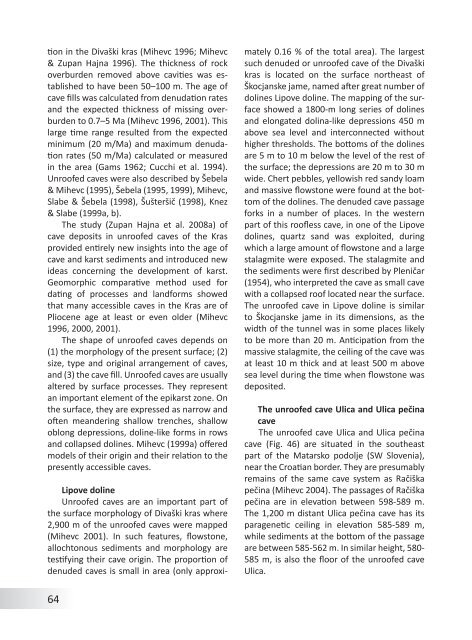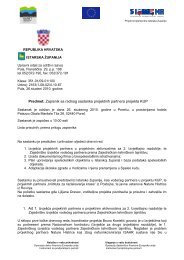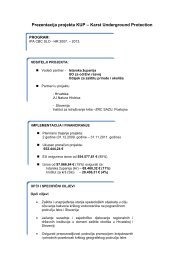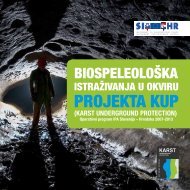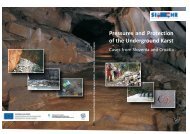Case Studies from the Dinaric Karst of Slovenia
Case Studies from the Dinaric Karst of Slovenia
Case Studies from the Dinaric Karst of Slovenia
Create successful ePaper yourself
Turn your PDF publications into a flip-book with our unique Google optimized e-Paper software.
tion in <strong>the</strong> Divaški kras (Mihevc 1996; Mihevc& Zupan Hajna 1996). The thickness <strong>of</strong> rockoverburden removed above cavities was establishedto have been 50–100 m. The age <strong>of</strong>cave fills was calculated <strong>from</strong> denudation ratesand <strong>the</strong> expected thickness <strong>of</strong> missing overburdento 0.7–5 Ma (Mihevc 1996, 2001). Thislarge time range resulted <strong>from</strong> <strong>the</strong> expectedminimum (20 m/Ma) and maximum denudationrates (50 m/Ma) calculated or measuredin <strong>the</strong> area (Gams 1962; Cucchi et al. 1994).Unro<strong>of</strong>ed caves were also described by Šebela& Mihevc (1995), Šebela (1995, 1999), Mihevc,Slabe & Šebela (1998), Šušteršič (1998), Knez& Slabe (1999a, b).The study (Zupan Hajna et al. 2008a) <strong>of</strong>cave deposits in unro<strong>of</strong>ed caves <strong>of</strong> <strong>the</strong> Krasprovided entirely new insights into <strong>the</strong> age <strong>of</strong>cave and karst sediments and introduced newideas concerning <strong>the</strong> development <strong>of</strong> karst.Geomorphic comparative method used fordating <strong>of</strong> processes and landforms showedthat many accessible caves in <strong>the</strong> Kras are <strong>of</strong>Pliocene age at least or even older (Mihevc1996, 2000, 2001).The shape <strong>of</strong> unro<strong>of</strong>ed caves depends on(1) <strong>the</strong> morphology <strong>of</strong> <strong>the</strong> present surface; (2)size, type and original arrangement <strong>of</strong> caves,and (3) <strong>the</strong> cave fill. Unro<strong>of</strong>ed caves are usuallyaltered by surface processes. They representan important element <strong>of</strong> <strong>the</strong> epikarst zone. On<strong>the</strong> surface, <strong>the</strong>y are expressed as narrow and<strong>of</strong>ten meandering shallow trenches, shallowoblong depressions, doline-like forms in rowsand collapsed dolines. Mihevc (1999a) <strong>of</strong>feredmodels <strong>of</strong> <strong>the</strong>ir origin and <strong>the</strong>ir relation to <strong>the</strong>presently accessible caves.Lipove dolineUnro<strong>of</strong>ed caves are an important part <strong>of</strong><strong>the</strong> surface morphology <strong>of</strong> Divaški kras where2,900 m <strong>of</strong> <strong>the</strong> unro<strong>of</strong>ed caves were mapped(Mihevc 2001). In such features, flowstone,allochtonous sediments and morphology aretestifying <strong>the</strong>ir cave origin. The proportion <strong>of</strong>denuded caves is small in area (only approximately0.16 % <strong>of</strong> <strong>the</strong> total area). The largestsuch denuded or unro<strong>of</strong>ed cave <strong>of</strong> <strong>the</strong> Divaškikras is located on <strong>the</strong> surface nor<strong>the</strong>ast <strong>of</strong>Škocjanske jame, named after great number <strong>of</strong>dolines Lipove doline. The mapping <strong>of</strong> <strong>the</strong> surfaceshowed a 1800-m long series <strong>of</strong> dolinesand elongated dolina-like depressions 450 mabove sea level and interconnected withouthigher thresholds. The bottoms <strong>of</strong> <strong>the</strong> dolinesare 5 m to 10 m below <strong>the</strong> level <strong>of</strong> <strong>the</strong> rest <strong>of</strong><strong>the</strong> surface; <strong>the</strong> depressions are 20 m to 30 mwide. Chert pebbles, yellowish red sandy loamand massive flowstone were found at <strong>the</strong> bottom<strong>of</strong> <strong>the</strong> dolines. The denuded cave passageforks in a number <strong>of</strong> places. In <strong>the</strong> westernpart <strong>of</strong> this ro<strong>of</strong>less cave, in one <strong>of</strong> <strong>the</strong> Lipovedolines, quartz sand was exploited, duringwhich a large amount <strong>of</strong> flowstone and a largestalagmite were exposed. The stalagmite and<strong>the</strong> sediments were first described by Pleničar(1954), who interpreted <strong>the</strong> cave as small cavewith a collapsed ro<strong>of</strong> located near <strong>the</strong> surface.The unro<strong>of</strong>ed cave in Lipove doline is similarto Škocjanske jame in its dimensions, as <strong>the</strong>width <strong>of</strong> <strong>the</strong> tunnel was in some places likelyto be more than 20 m. Anticipation <strong>from</strong> <strong>the</strong>massive stalagmite, <strong>the</strong> ceiling <strong>of</strong> <strong>the</strong> cave wasat least 10 m thick and at least 500 m abovesea level during <strong>the</strong> time when flowstone wasdeposited.The unro<strong>of</strong>ed cave Ulica and Ulica pečinacaveThe unro<strong>of</strong>ed cave Ulica and Ulica pečinacave (Fig. 46) are situated in <strong>the</strong> sou<strong>the</strong>astpart <strong>of</strong> <strong>the</strong> Matarsko podolje (SW <strong>Slovenia</strong>),near <strong>the</strong> Croatian border. They are presumablyremains <strong>of</strong> <strong>the</strong> same cave system as Račiškapečina (Mihevc 2004). The passages <strong>of</strong> Račiškapečina are in elevation between 598-589 m.The 1,200 m distant Ulica pečina cave has itsparagenetic ceiling in elevation 585-589 m,while sediments at <strong>the</strong> bottom <strong>of</strong> <strong>the</strong> passageare between 585-562 m. In similar height, 580-585 m, is also <strong>the</strong> floor <strong>of</strong> <strong>the</strong> unro<strong>of</strong>ed caveUlica.64


